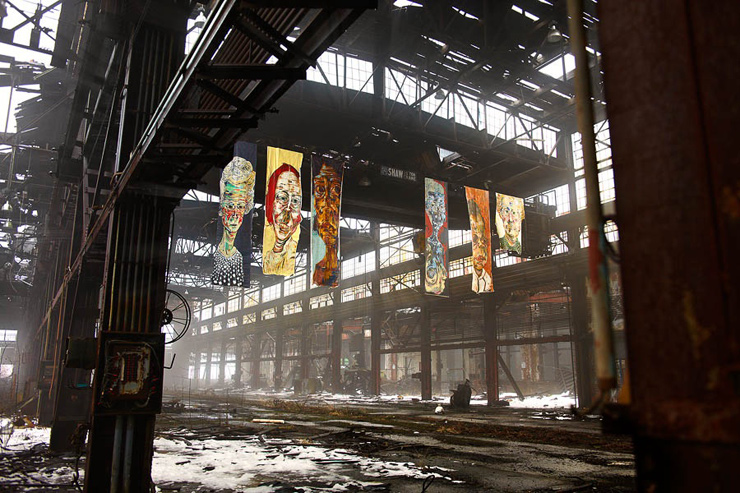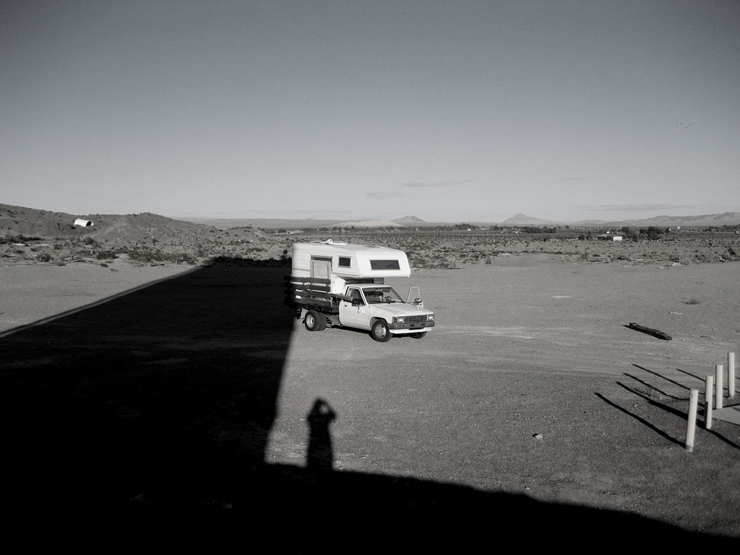Saturday, December 10, 3-5pm
we will have all sorts of CFYW stickers – and EVERYBODY likes stickers, right?!
Saturday, December 10, 3-5pm
we will have all sorts of CFYW stickers – and EVERYBODY likes stickers, right?!
Her name is unpronounceable, so people just call her Mrs. Bennett. One of the last aboriginal people in Australia, she sits atop a rolling line of four-eyed Tibetan demons with human faces who are sucking species into their mouths on this wall installation at the Institute of Contemporary Art/Boston (ICA). Traditionally these demons would be protective, but “Swoon really sees these as a representation of humanity’s need to devour, and in excess, to destroy“ explains Pedro Alonzo, curator of the show, as he gives guests a tour of “Anthropocene”, the two part installation by the Brooklyn Street Artist. The shows’ name refers to the current era, and according to Wikipedia, “The Anthropocene is a recent and informal geologic chronological term that serves to mark the evidence and extent of human activities that have had a significant global impact on the Earth’s ecosystems.”
Part two of the installation at this modern museum overlooking the Boston waterfront is the mini temple suspended from the ceiling in the entry hall to the galleries, best viewed from the glass central elevator that carries you from floor to floor. With joints hand-tied in a manner Swoon learned from Chinese scaffolding architecture, the 400 pound structure is made of bamboo, copper, and multiples of hand cut paper animals, species endangered or soon to be in this era of human destruction on Earth. “She built the structure in four parts, we assembled it and installed it (over 6 days), and she draped it with these materials, ” said Alonzo.
During the installation the main hall was reserved for work tables and a temporary print shop, where many assistants spent hours hand cutting the animals and shapes that adorn the works and the parade that swings from the ceiling connecting the two areas. Seahorses, frogs, beetles, and butterfies all create the chain of life in this intuitive biologic story of connective species and collective endangerment. Disappearing before they can become fossils, the animal world is memorialized in this most ephemeral of materials, an exhibition that will similarly be destroyed when the wall is sanded and painted. In this impermanent way, it best mimics the installations Swoon does on the street.
Then out to the streets of Boston we went, hitting a number of spots with the guidance of photographer, artist, and Street Art expert Geoff Hargadon, who began one of the city’s only organic walls for Street Art and graffiti art in 2007. A natural magnet for painters and wheat-pasters, the ever-changing dialogue of “The Wall” on display is periodically wiped clean for a new group installation. The outdoor gallery has provided an outlet for hundreds of local and visiting artists as well as a providing a backdrop to photo shoots, video, and television programs. On the day we were there, a dancer was set to perform her moves under bright lights in the alleyway. Below are images from that days tour.
With special thanks to Swoon, Pedro Alonzo, the ICA, and sincere gratitude to Geoff Hargadon.
It’s been a few weeks since BSA first showed images of the protesting marchers of Occupy Wall Street and the number of everyday people from many walks of life in the streets has only bolstered what the kids have been saying. Now it looks like the marches have spread to hundreds of other cities in the country and around the world. All this in less than a month? It’s like it was waiting to happen.
In the intervening days the rapidly blossoming movement has been endorsed and reviled by many a political figure and well-known media personality. While some shiny happy telecasters seem bewildered by the discontent – the majority of people you talk to on the street or whom you stand behind at the grocery store or bank aren’t particularly mystified by the marchers or their myriad messages. It’s the same stuff people have been talking about at their kitchen table for years now – and now they’re talking together in the public square. Oops.
Aside from the populist uprising aspect of it all, the art in the street during these Occupy marches has been pretty good. So have been the slogans, the witty turns of phrase, the clever costumes and dramatic street theater. Is there any question that Street Art will be reflecting what is happening in the streets? In many ways, it already has been – our recent talks at LA MOCA and the New York State Museum concentrated on the tea leaves of the street telling us for the last few years about homelessness, the effects of war, the struggles of the working class, and the housing crises. For many Street Artists this stuff is personal and they’ve been telling their stories with their art.
Here are some of the scenes we caught of the Occupy Boston and Occupy Wall Street marches recently; it will be very interesting to see how art and popular culture are influenced by what is now on display in the Streets. When you call yourself the 99%, you’ve cast a pretty wide net.
 Swoon at work installing “Anthropocene Extinction” (photo © Geoff Hargadon)
Swoon at work installing “Anthropocene Extinction” (photo © Geoff Hargadon)There’s a good chance you’ve encountered Swoon’s work before: her intricately cut, life-sized portraits have covered abandoned buildings and warehouses in cities around the world. Often found in beautiful states of decay, her wheat-pasted installations are populated by realistically rendered people going about everyday activities in a cityscape of her own invention.
In both her art and her own life, Swoon is deeply engaged with social and humanitarian projects. During the 2009 Venice Biennale, she and a crew of 30 other artists and friends sailed SWOON boats made of reclaimed materials through the canals of Venice—creating new purpose out of what was cast aside. Her latest endeavor, the Konbit Shelter Project, is a sustainable building project assisting Haitians who lost their homes in the devastating 2010 earthquake. Working alone or in collaboration, Swoon’s work is often about forming a community in order to practice what she refers to as a “real world” engagement.
For the ICA’s fifth installation of the Sandra and Gerald Fineberg Art Wall, Swoon’s installation will extend from the elevator atrium to the lobby, soaring 40 feet up to the ceiling—the largest installation to occupy the Fineberg Art Wall. The work, titled Anthropocene Extinction, is composed of streams of intricately cut paper which connect key sculptural elements within the installation, including a 400-pound, suspended bamboo sculpture. The exhibition is accompanied by an ICA-produced video featuring installation footage and an interview with the artist.
To find out more about this exhibit, location, time, dates and directions visit ICA site at:
http://www.icaboston.org/exhibitions/upcoming-exhibitions/swoon/
 Swoon (photo © Geoff Hargadon)
Swoon (photo © Geoff Hargadon)Opening tonight at the Institute of Contemporary Art in Boston, is an exhibition of new work by Brooklyn Street Artist SWOON, called Anthropocene Extinction.
“The title addresses humanity’s impact on the environment,” says Pedro Alonzo, the Adjunct Curator of the show and the guy who brought the very successful Street Art exhibition “Viva La Revolucion” to San Diego last year.
Kind hearted and focused powerhouse SWOON continues her efforts to engage viewers at ICA with her hand cut wheat pasted installations of real people and mythical ones, symbolically telling a tale that brings responsibility for the environment directly to our feet. Wholistic in many respects, we find familiar recurring themes in the subject matter, the construction techniques, even the manner of fruition of the installations; The localized environment in which Swoon’s work evolves mirrors the collaborative vision and processes that will be necessary to address the very real issue of sustainability and disaster more populations are facing.
For the politically charged time we’re in, a show like this could open itself to charges of smug liberal self satisfaction if the artists’ body of work and projects to create shelter from the storm were not so consistent and authentic. A person entirely engaged in every process, Swoon facilitates others’ stories and incorporates them along with more material considerations, like the 400-pound bamboo temple structure hanging from the ceiling here that uses traditional Chinese construction methods the artist has been studying (It’s excellent when viewed while riding the elevator). Balancing the durability of reinforced joints with the fragility of cut paper species floating through air, the exhibit calls to mind the range of responses we will need to employ if the march toward planetary destruction is to reverse, and if SWOON’s characters are going to survive.
Our thanks to photographer and BSA contributor Geoff Hargadon, who has been documenting Swoon’s installation for the show and who shares images with you here.Support for the Swoon installation is provided by Fotene Demoulas and Tom Coté, Geoff Hargadon and Patricia La Valley, Tim Phillips, and Connie Coburn and James Houghton.
Learn more about the exhibition Anthropocene Extinction at the ICA website HERE:
Read BSA’s interview with Pedro Alonzo here about his curatorial experiences on Viva La Revolución at the Museum of Contemporary Art San Diego last year.
Listen to an interview with Swoon and Pedro Alonzo on Boston’s WBUR.
The fine artist and Street Artist named Purth has been completing an urban installation of her family this winter in Austin, Boston, Brooklyn, Cincinnati, and New Orleans . Not literally her blood relatives, the oversize portraits of females are mirrors of her emotional journey and echoes of relationships she may have experienced coupled with ones she is creating for her future. Coupled with bits of prose that ground them somewhat, these women are strong and searching.
This kind of internal migration is not unusual for a painter in scanning the horizon for something however the actual physical distance run, with it’s long spaces of time and travel in between, is. It’s also something that Street Artists around the globe are setting a new standard for by completing installations in towns and cities around the globe much like a campaign. In her dog-eared travelogue, Purth carries ruddy hued people from her fluid imagination and raises them amidst abandoned rubble; high enough to be seen from a distance.
 Purth “The Deleras” group in an abandoned train yard east of Boston. (Photo © Heather McGrath)
Purth “The Deleras” group in an abandoned train yard east of Boston. (Photo © Heather McGrath)Having completed roughly the first half of the installations for “The Deleras Project”, she shares these images before Purth hits the road again to complete it with installations in Oakland, Los Angeles, Minneapolis, Chicago, Detroit and Cincinnati.
With the completion of “six months on the road, (with) snow storm & tornadoes endured, a car accident survived, and life affirming environments broken into,” the artist took a moment to chat with Brooklyn Street Art about her project:
Brooklyn Street Art: Who are the individuals depicted on your paintings?
Purth: Each piece was created from different sources of inspiration: references of old photographs I’ve been collecting for years, reflections … perhaps of someone’s lover, someone’s child. There will be ten once the work is completed, all of women, young & old, scattered across the country, & each installed with a single stream of thought. The writing is sourced in a very similar way … some pulled from found material, some from the words I was lucky enough to hear uttered; fragments to create a whole. I guess in my mind, they have become the women they are now. Completely independent of the remnants that built them up or who they are to me personally. I hope that for them … the right to stand on their own.
Brooklyn Street Art: Why are you traveling around the country putting them up on abandoned walls and buildings?
Purth: Abandoned spaces have a pronounced hum to them. They are shed, in a sense, but are still heavy with profound undercurrents that I believe can be tapped into … & reinvented. It seems completely fitting for me to search out these spaces as possible locations for the work even if they ultimately make home above, along side, or in areas close by. In regards to the distance covered … we have gaps that need to be bridged. I see them as shepherds and black sheep. It’s my responsibility to find them home.
Brooklyn Street Art: What is the genesis of this project?
Purth: The first, Delera, was created at an intense, pivotal moment in my life. I became very weak around the end of 2009 and I began painting her like a child screaming at an overbearing parent. In the simplest sense, I was depicting the strength I needed to rediscover in myself. Once she was suspended and I saw her upright for the first time, she literally took my breath away. Something so intimate, so tender, and so sincere towering over me … it was like gold leafing vulnerability and then lighting the shit on fire.
She was the first, the idea for the others quickly followed.

Barbara Krakow Gallery
The Annual AIDS Benefit Exhibition 2010
December 11, 2010 – December 17, 2010
Anything But Paper Prayers
All works available for a $350 donation to the Boston Pediatric Aids Initiative or The African Aids Initiative